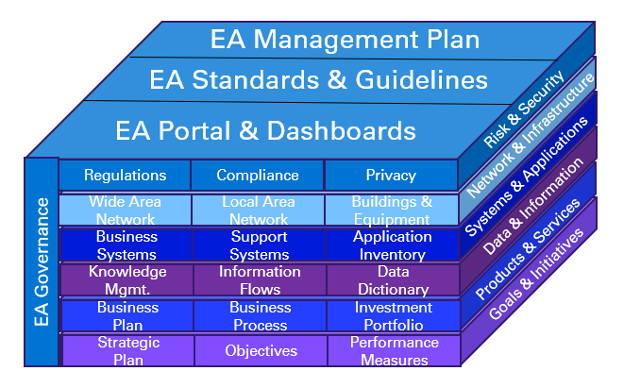
By Bala Kalavala, Chief Architect & Technology Evangelist
Summary
The article explores the transformative potential of AI in revolutionizing enterprise architecture. It highlights the key benefits of AI, including enhanced decision-making, improved efficiency, risk mitigation, and cost optimization. The article discusses various AI applications in enterprise architecture, such as intelligent data modeling, predictive analytics, process optimization, and security analysis. It also addresses the challenges and considerations associated with AI implementation, including data quality, ethical concerns, and integration challenges. By leveraging AI, organizations can unlock new opportunities, streamline operations, and gain a competitive edge in today’s rapidly evolving digital landscape.
Introduction
AI is transforming enterprise architecture (EA) in ways and evolving patterns beyond the wildest imagination possible to thought leaders just a few years ago. AI’s rapid data processing ability supports informed decision-making, bringing integration that unlocks efficiency and innovation in the architecture and design of enterprise applications while improving data quality through automated collection and curation of organizations’ unstructured content. AI accelerates the architecture thought process by generating tailored solution design patterns, allowing architects to explore innovative solution implementation approaches.
As a strategic framework, EA guides the design of business processes, data and information systems, and technology, aligning IT with business strategy to enhance efficiency, manage risk, and improve technology decision-making. Integrating AI throughout the EA lifecycle helps organizations analyze internal knowledge repositories, predict technology needs, automate routine application assessments, and simulate implementation scenarios while generating test strategies, approaches, and a hypothesis on performance expectations. This fosters digital transformation at speed and scale, providing a competitive edge.
AI also optimizes architecture resource allocation across disciplines, such as enterprise architecture, solution architecture, domain architecture, and technology architecture. It forecasts solution demands through predictive analytics, ensuring effective allocation of architecture thought leadership while supporting the organization’s greater mission and vision and balancing strategy and operations.
Collaborative EA Framework
The (EA) framework provides a comprehensive view of the company’s IT landscape with various business and technology domain-specific visualizations built on the EA repository. It encompasses a multi-layered structure, each layer interconnected and essential for the enterprise’s overall effectiveness. The visual attempts to demonstrate the interdependent organization content created by multiple individuals’ service-specific purposes and causes, often at different times, leading to challenges in collating meaningfully as an organization-level asset. Typically, such a task is undertaken by a dedicated enterprise architecture team supported by solution architects and subject matter experts; many organizations dedicate minimal effort to enabling the EA framework due to competing priorities and limited resources. AI has the potential to change all of that; before digging into it, let’s look at critical tenants of the EA framework and their role.

Figure: Collaborative EA Framework
The framework is built on EA Governance, which ensures compliance with regulations and safeguards sensitive information. The EA Management Plan then outlines the strategic direction of the EA program, aligning it with business objectives and monitoring performance.
The EA Standards & Guidelines layer defines the standards for designing, developing, and implementing enterprise solutions, including network and physical infrastructure and application development. The EA Portal & Dashboards layer provides a centralized platform for accessing EA information and supports knowledge and data management.
The Business Systems layer highlights the critical systems supporting the organization’s operations, including business processes and application inventory. The Risk and security layer focuses on managing security and risk and protecting network infrastructure, systems, applications, and sensitive data.
The Products & Services layer emphasizes the organization’s offerings by managing their lifecycle, establishing goals and initiatives, and ensuring alignment with the overall EA strategy.
The EA framework provides a comprehensive view of the enterprise, enabling integrated planning and management. Aligning business strategy with IT capabilities helps organizations achieve their goals and adapt to changing needs.
Enterprise Architecture Lifecycle Enhanced with AI
Now that we have reviewed the fundamentals of EA and AI let’s see how they come together in a typical EA lifecycle journey. By leveraging AI, let’s review a typical EA lifecycle with the potential for AI-driven enhancement for each.

Figure: AI-Driven Enterprise Architecture Lifecycle
AI-Powered Strategic Planning
AI utilizes ML to develop architecture and design pattern insights that technical experts might overlook or may not be looking for. A use case could be AI analyzing historical technology project data to forecast future product demand, enabling better application design, improved project management, and more efficient technology investment planning for enhanced organizational success.
AI-Driven Performance Monitoring & Analytics
AI can significantly enhance EA reusable knowledge repositories, architecture diagrams, and visualizations by analyzing real-time and historical projects, programs, solution designs, and other relevant data to identify anomalies, bottlenecks, and optimization opportunities in designing robust technology solutions. AI-powered solution design monitoring systems could detect a sudden increase in website traffic and automatically scale server resources to handle the increased load; such measures could have cost and end-user experience issues that could potentially impact business. Technical experts can apply the insights learned to ensure the future design of robust solutions by considering aspects of application behavior that may not have been considered.
AI-Enhanced Architecture Design
AI can streamline the architecture design process by generating multiple design options, simulating different scenarios, and optimizing designs based on performance and cost. Using generative design techniques, AI can create innovative and efficient solution design patterns that would be difficult or non-pragmatic to achieve through traditional methods. For example, an AI-powered design tool could generate multiple network designs, each with different topologies and configurations, and then evaluate the performance and cost of each design to identify the optimal solution.
AI-Powered Business Process Optimization
AI can identify inefficiencies, identifying routine patterns in business processes by recommending the automation of tasks, and optimizing workflows. By analyzing process data, AI can identify bottlenecks, redundant steps, and opportunities for automation. For example, an AI-powered robotic process automation (RPA) tool could automate repetitive architecture tasks, such as data entry or report generation, freeing up architects to focus on more thought leadership and solution design work; this is especially true for architecture repositories kept up to date in ensuring the AI-driven EA practice always has real-time data.
AI-Driven Compliance Monitoring
AI can help EA enable compliance with regulations and standards by automating compliance monitoring and identifying potential design risks in architecture solutions. AI can detect anomalies and deviations from security and compliance policies. For example, an AI-powered compliance monitoring tool could analyze regulatory policies and guidelines against solution designs and deployment information like CMDB data for risk and compliance documentation comparison to identify gaps that can be addressed proactively before they become concerns or threats.
AI-Assisted Design Validation
AI can validate solution designs against requirements, identifying potential flaws and ensuring adherence to standards. Using machine learning algorithms, it can identify patterns in design failures and predict potential issues before they occur. For example, an AI-powered design validation tool could analyze circuit designs to identify potential short circuits or other electrical problems.
AI-Driven Roadmap Planning
Road mapping from the current state to the target state, meeting specific guidelines, policies, and procedures an organization has set, is always a tedious task; representing all of the solutions’ objectives in a comprised yet understandable way has always been challenging. AI can create effective roadmaps by collating all the documentation, including forecasting future technology trends, identifying potential disruptions, and aligning the roadmap with business strategy. By analyzing market trends, competitive landscapes, and emerging technologies, AI can help architects anticipate future challenges and opportunities.
AI-Enhanced Decision Support
By analyzing the EA repository, AI can enable decision-makers to identify IT spending patterns and gaps or spending performance compared to internal initiatives or external benchmarks in support of architecture-led recommendations in budget reallocations.
Conclusion
Enabling EA lifecycle and repository management with AI collaboratively across all company knowledge repositories can help organizations achieve agility, optimize resources, and drive sustainable growth. Embracing AI-driven EA is essential for staying competitive in today’s dynamic business environment.
Reference:
- Effects of AI on EA: https://ieeexplore.ieee.org/abstract/document/9626249
- Impact of Big Data on EA Design: https://jurnal.itscience.org/index.php/CNAPC/article/view/3449
- Machine learning and IoT apps in EA: https://onlinelibrary.wiley.com/doi/full/10.1111/exsy.13467
Kalavala is a seasoned technologist enthusiastic about pragmatic business solutions influencing thought leadership. He is a sought-after keynote speaker, evangelist, and tech blogger. He is also a digital transformation business development executive at a global technology consulting firm, an Angel investor, and a serial entrepreneur with an impressive track record.
The article expresses the view of the author and doesn’t express the view of his organization.
